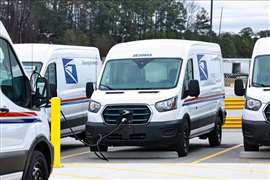Read this article in Français Deutsch Italiano Português Español
Xeal’s EV charging approach uses edge computing to mitigate connectivity-related downtime
08 April 2024
While much of the research related to public electric vehicle (EV) charging station failures comes from consumers, the malfunctions themselves are vehicle-agnostic. As such, commercial vehicles can be affected, as well.
Last May, J.D. Power reported that according to its 2023 U.S. Electric Vehicle Experience Public Charging Study, just over 20 percent of EV drivers reported charging station failures and malfunctions through the end of Q1 2023. A white paper entitled “Electrification 2030” from Qmerit, which provides EV charging installation services, enumerated the reasons for these failures. At the top of the list: charging station connectivity (55 percent of failures).
EV charging ‘uptime’ poorly defined across the industry
Many people would define the term “uptime” as a machine’s or organization’s ability to reliably perform its stated duties. When it comes to electric vehicle (EV) charging, then, one might believe that uptime means the ability to consistently charge a vehicle. However, according to Mike Smith, head of deployments and policy for Xeal, the notion of uptime for EV charging is not agreed upon within the industry.
“Right now, there’s no real standard for what uptime means,” he said. “So, what you have is, you have a whole bunch of companies creating their own definitions, creating their own formulas. It’s as if we were playing a game together, but you had your own rules, and I had my own rules.”
As an example, Smith said that some charging companies might advertize uptime of 96 to 99 percent, but they are putting caveats against those claims by saying they don’t include the connectivity losses that cause an EV charger to malfunction. They do this because they are unable to control connectivity.
To address this, some states are seeking to bring consistency to the definition of uptime in EV charging.
“What we’re seeing now is kind of a harmonization of what it means to be ‘up,’” Smith said, “and even formulas that places like the state of California are working on for every single charging company to have a report on.” He added that these reports and standards should allow customers to have a degree of confidence in the reliability of an EV charging brand.
Unlike filling a vehicle’s fuel tank with gasoline or diesel, which is purely about dispensing fuel, EV charging requires information to be shared between the vehicle and charger. Mike Smith, head of deployments and policy for New York City-based EV charging company Xeal, said this data could include information about the health of the charger, the amount of energy delivered, whether there was a demand response, how much the driver paid, etc.
“There are so many more smart functions that happen with both reporting and the payment side that require a robust connection to process and keep track of that information,” he said. “That’s the big thing with smart charging — utilities want to see this data.”
According to Smith, the traditional method to authenticate at an EV charger as well as retrieve and store this information is through an active internet connection.
“Current [charging] systems go via cellular, they go through the building’s Wi-Fi or the building cellular plan, go through the antenna on the top of the building, all the way to AWS (Amazon Web Services) in Atlanta and all the way back,” he said. “If there’s any breakage in that system, you may not be able to process a payment, authenticate a user to charge. And that’s where we’re seeing the lion’s share of the problems in smart charging.”
Xeal has first-hand knowledge of the challenges that come from smart charging connectivity issues.
“Our beginning really started in a parking garage in California where our CTO stayed up all night manually starting and stopping charging sessions because the Wi-Fi in the parking garage went down,” Smith said. “It was our second client, and it couldn’t charge. We wanted to make sure we didn’t lose those clients, so what we had do was sit in the corner all night starting and stopping sessions. It was at that point where our CTO figured someone else is having this problem. It’s not only us. There has to be a better way.”
It was an experience Smith said drove Xeal to develop a more reliable charging solution — one that could mitigate connectivity-related issues.
“In 2019 was when we released our new communication protocol that we call Apollo,” he said. Calling it the company’s “secret sauce,” it is part of a hardware and software system that capitalizes upon the computing power of the modern smartphone. It substitutes the need for the charger to connect immediately to the internet with the ability to connect instead with an app on a smartphone.
“We bring the computing power directly there,” Smith said. “It’s just the phone and the charger. They talk to each other, they handshake, they share information, and then that’s it. It doesn’t have to go to any sort of cloud system.”
When asked if Xeal’s approach was essentially edge computing, Smith said, “That’s exactly how our system is designed. Whether a person has great cell reception or great Wi-Fi at that point of charge, it will upload the information that has been captured from the charger — upload it instantaneously. Or if there’s no cell service in their area, when they regain connectivity in the background, it’ll push that information to be stored in our cloud.”
According to Smith, the Xeal solution is designed to work with either automobiles or commercial EVs.
“We’ve really created our Apollo protocol to be used for not just Level 2, but even DC fast charging,” he said. “So, we’ve created it in a way that it’s a platform that’s able to be open and to be used by other companies.”
POWER SOURCING GUIDE
The trusted reference and buyer’s guide for 83 years
The original “desktop search engine,” guiding nearly 10,000 users in more than 90 countries it is the primary reference for specifications and details on all the components that go into engine systems.
Visit Now
STAY CONNECTED




Receive the information you need when you need it through our world-leading magazines, newsletters and daily briefings.
CONNECT WITH THE TEAM














